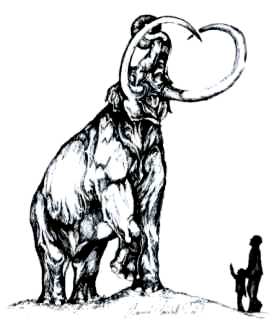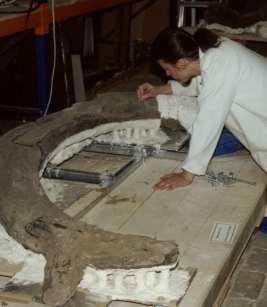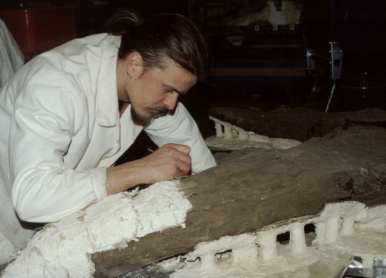![]() The West Runton Elephant Project
The West Runton Elephant Project
![]() The West Runton Elephant Project
The West Runton Elephant Project
This project has now been written up and published:
Literally a ‘mammoth task’: The conservation, preparation and curation of the
West Runton Mammoth skeleton. By Nigel Larkin, in 'Quaternary International'. Available online 15 July 2010.
Also:
Taphonomy of the West Runton Mammoth. By Anthony J. Stuart & Nigel R. Larkin, in 'Quaternary International'. Available online 6 July 2010.
You can find abstracts of these papers at Nigel's site on Academia.edu:
http://norfolk.academia.edu/NigelLarkin/Papers.
Nigel Larkin joined Norfolk Museums and Archaeology Service in 1996 as a Palaeontological Conservator in the Conservation Department to manage the West Runton Elephant Conservation Project. This two-year temporary contract, mainly financed by the Heritage Lottery Fund, was to design and implement the remedial and preventive conservation strategies for the West Runton Elephant material and the associated fauna (several hundred sub-fossil Pleistocene specimens). This included managing personnel, creating temporary displays, delivering talks to the public, casting replicas for research purposes, testing materials and publishing conservation research. Other departmental responsibilities included: identifying geological specimens; undertaking collections surveys; advising the public on geological conservation; and installing and maintaining various environmental monitoring systems.
The material itself had superb surface detail, but was extremely fragile. This elephant skeleton is the best known example of Mammuthus trogontherii in the world. This species is the biggest of all the elephnats that ever lived, standing over four metres high and weighing about ten tonnes when alive - twice the weight of a modern African elephant. This is bigger than most dinosaurs, only the largest saurapods would have been bigger and heavier. The material, however, is only about 650,000 years old. This is long enough for all the collagen and other organics (which give a bone its strength and flexibility) to have totally deteriorated, but not long enough for any mineralisation of the bone to have taken place. This meant that the all the bones consisted only of a brittle mineral matrix. They were also penetrated by deep networks of cracks due to the weight and movement of kilometre-high glaciers passing overhead during the more recent ice-ages. The fact that the bones themselves are huge and so heavy that most of the limb bones need two or more people to move them meant that the unique combination of their size, weight and fragility presented a unique problem. And because this is the most complete skeleton of this species ever found (at 85% complete, it far exceeds the next best skeletons known which are only 10-15% complete) we had to be extra cautious when devising our conservation and storage strategies.








The material had to be freed from the surrounding plaster and steel jackets, cleaned with a mixture of small wooden handtools, dental picks and an airbrasive - mostly under microscopes so we didn't damage the surface. Then the breaks were consolidated and fixed with a reversable, very stable, and well-tested adhesive. When the bones had been cleaned, stabilised, fixed and identified, the smaller bones were labelled and laid in depressions cut for them out of inert, archival, foam, in archival storage boxes specialy made for them. The larger bones had rigid foam-lined jackets made for them to lie on, the very heaviest permanently placed on specialy-made trolleys so they did not have to be lifted. All the bones were put into a stable climate-controlled storage area. The boxes and jackets were made so that the least amount of handling is necessary to study the bones. The bones are also located on numbered shelves which are further divided into labelled segments, so that anyone wanting the bones can look them up (by species name, common name, or field number) in the index of specimens and go right to the box they need without rummaging and moving more specimens than necessary. Many of the bones can be studied without removing them from their boxes. The larger bones in rigid jackets can have a "top" jacket bolted onto them, then be turned over and the "bottom" jacket taken off, if the underside needs to be studied.





Specific responsibilities included:
Grants personally secured from external sources towards this project (Total is £ 44,500):
· 1997. MGC PRISM (Preservation of Industrial and Scientific Material) Grant Fund: £20,000 towards the cost of an assistant palaeontological conservator for the WRE Conservation Project.
· 1998. MGC Partnership Project Grant: £2,000 towards a conservation research project "Study of seal integrity and material degradation of polyethylene and polypropylene containers" (research undertaken with Gillian Comerford of the NHM PCU).
· 1999. MGC PRISM Grant Fund: £20,000 towards conserving the varied collections of the Castle Museum's Natural History Department prior to their removal to another location.
· 1999. £2,500 in SEMS Grants towards the West Runton Elephant Project.
For more details about what we can do for you, or for a quote, please contact:
enquiries@natural-history-conservation.com
We are members of the United Kingdom Institute for Conservation of Historic and Artistic Works